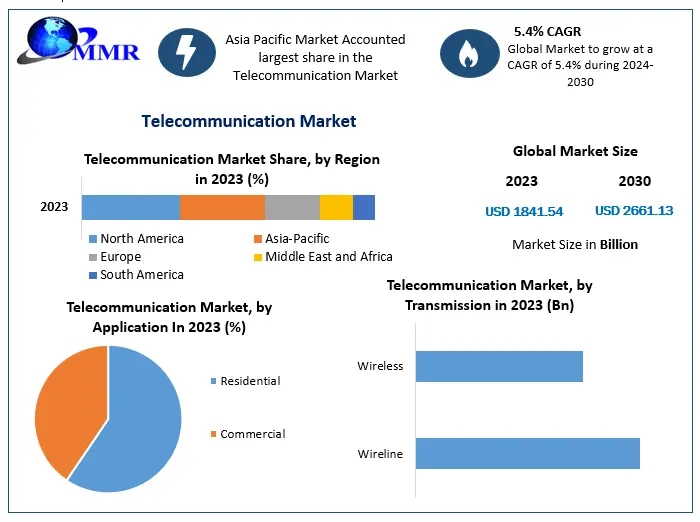Now Reading: Global Telecommunication Market Set to Surpass USD 2.66 Trillion by 2030 Driven by 5G, IoT, and Digital Innovation
-
01
Global Telecommunication Market Set to Surpass USD 2.66 Trillion by 2030 Driven by 5G, IoT, and Digital Innovation
Global Telecommunication Market Set to Surpass USD 2.66 Trillion by 2030 Driven by 5G, IoT, and Digital Innovation

The Global Telecommunication Market is set for significant growth, with projections indicating a rise from USD 1,841.54 billion in 2023 to around USD 2,661.13 billion by 2030. This growth, expected at a compound annual growth rate (CAGR) of 5.4%, is being primarily driven by the rapid deployment of 5G, increasing data consumption, and swift digitization across various sectors of the economy.
The telecommunication industry involves the transmission of data, voice, images, and video over distances using electrical or optical signals. Acting as the foundation of global communication systems, it includes technologies like mobile networks, broadband internet, satellite systems, and fixed-line telephony.
In 2023, the market was valued at USD 1,841.54 billion, showcasing its crucial role in linking people, devices, and businesses worldwide. With the growing reliance on data-driven technologies and high-speed internet connectivity, the market is anticipated to surpass USD 2.66 trillion by 2030, indicating vast potential for innovation and infrastructure development.
Interested in understanding market dynamics? Obtain a complimentary sample to explore the latest insights here: https://www.maximizemarketresearch.com/request-sample/23743/
Drivers of Market Growth and Opportunities
1. Expansion of 5G Infrastructure: The global implementation of 5G technology is a key growth factor in the telecommunications industry, offering faster speeds, lower latency, and support for a wider range of connected devices essential for applications in smart cities, autonomous vehicles, augmented reality, and telehealth services.
2. Surge in Mobile Data Consumption: With mobile devices becoming the primary gateway to the internet for billions of users, mobile data consumption is rising significantly, driven by activities like video streaming, social media usage, and cloud-based applications.
3. Digital Transformation Across Sectors: Various industries such as healthcare, retail, education, and finance are undergoing substantial digital transformations, facilitated by telecommunication services enabling virtual classrooms, telemedicine, online banking, and e-commerce platforms.
4. Rural and Remote Connectivity Initiatives: Global efforts to bridge the digital gap are creating new opportunities by providing internet access to underserved regions, leading to market expansion in rural areas through partnerships between governments and private entities deploying fiber-optic and wireless networks.
5. Cloud Integration and Edge Computing: The increasing adoption of cloud-based solutions and the demand for real-time data processing are driving the uptake of edge computing technologies, prompting telecommunications infrastructure to adapt to support distributed computing models and offer hybrid cloud solutions to enterprises.
Segmentation Analysis
The global telecommunication market is segmented by product type, component, enterprise size, and industry, each providing distinct insights into demand trends and growth prospects.
By Product Type:
– Mobile Data
– Mobile Voice
– Fixed Data
– Fixed Voice
By Component:
– Hardware
– Software Platform
– Services
By Enterprise Size:
– Large Enterprises
– Small and Medium Enterprises (SMEs)
By Industry:
– IT and ITES
– Healthcare and Pharmaceutical
– Media and Entertainment
– Retail and E-Commerce
For further insights into market analysis, refer to the summary of the research report: https://www.maximizemarketresearch.com/market-report/global-telecommunication-market/23743/
Country-Level Insights
United States: The U.S. telecommunication market remains at the forefront globally, with advanced 5G rollouts, dense urban connectivity, and a competitive provider landscape driving trends such as AI integration in customer service and increased mobile data consumption.
Germany: As a key European market, Germany features strong regulatory oversight, widespread broadband access, and innovation in mobile and fixed-line services, with investments in smart city infrastructure and rural broadband connectivity shaping the future of telecom in the country.
Competitive Landscape
The telecommunications industry is characterized by consolidation and intense competition, with major players offering diverse services ranging from mobile networks to cloud solutions. Leading participants include global mobile and broadband service providers, enterprises focusing on 5G infrastructure deployment, and vendors emphasizing cloud-native solutions and edge computing.
Conclusion
The global telecommunication market is poised for significant growth driven by technological advancements and digital transformation across industries. With innovations such as 5G deployment, cloud computing, and AI-driven solutions reshaping the sector, telecom services are playing a pivotal role in shaping modern economies and societies, fostering a dynamic and evolving landscape for connectivity and communication.





